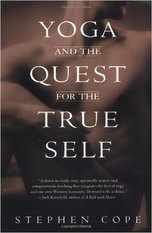
Yoga and the Quest for the True Self by Stephen Cope
Millions of Americans know yoga as a superb form of exercise and as a potent source of calm in our stress-filled lives. Far fewer are aware of the full promise of yoga as a 4,000-year-old practical path of liberation—a path that fits the needs of modern Western seekers with startling precision. Now Stephen Cope, a Western-trained psychotherapist who has lived and taught for more than ten years at the largest yoga center in America, offers this marvelously lively and irreverent "pilgrim's progress" for today's world. He demystifies the philosophy, psychology, and practice of yoga, and shows how it applies to our most human dilemmas: from loss, disappointment, and addiction, to the eternal conflicts around sex and relationship. And he shows us that in yoga, "liberation" does not require us to leave our everyday lives for some transcendent spiritual plane—life itself is the path. Above all, Cope shows how yoga can heal the suffering of self-estrangement that pervades our society, leading us to a new sense of purpose and to a deeper, more satisfying life in the world.
Millions of Americans know yoga as a superb form of exercise and as a potent source of calm in our stress-filled lives. Far fewer are aware of the full promise of yoga as a 4,000-year-old practical path of liberation—a path that fits the needs of modern Western seekers with startling precision. Now Stephen Cope, a Western-trained psychotherapist who has lived and taught for more than ten years at the largest yoga center in America, offers this marvelously lively and irreverent "pilgrim's progress" for today's world. He demystifies the philosophy, psychology, and practice of yoga, and shows how it applies to our most human dilemmas: from loss, disappointment, and addiction, to the eternal conflicts around sex and relationship. And he shows us that in yoga, "liberation" does not require us to leave our everyday lives for some transcendent spiritual plane—life itself is the path. Above all, Cope shows how yoga can heal the suffering of self-estrangement that pervades our society, leading us to a new sense of purpose and to a deeper, more satisfying life in the world.
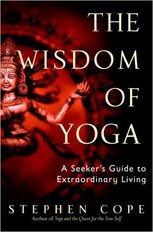
The Wisdom of Yoga by Stephen Cope
For modern spiritual seekers and yoga students alike, here is an irreverent yet profound guide to the most sophisticated teachings of the yoga wisdom tradition–now brought to contemporary life by a celebrated author, psychotherapist, and leading American yoga instructor.
While many Westerners still think of yoga as an invigorating series of postures and breathing exercises, these physical practices are only part of a vast and ancient spiritual science. For more than three millennia, yoga sages systematically explored the essential questions of our human existence: What are the root causes of suffering, and how can we achieve freedom and happiness? What would it be like to function at the maximum potential of our minds, bodies, and spirits? What is an optimal human life?
For modern spiritual seekers and yoga students alike, here is an irreverent yet profound guide to the most sophisticated teachings of the yoga wisdom tradition–now brought to contemporary life by a celebrated author, psychotherapist, and leading American yoga instructor.
While many Westerners still think of yoga as an invigorating series of postures and breathing exercises, these physical practices are only part of a vast and ancient spiritual science. For more than three millennia, yoga sages systematically explored the essential questions of our human existence: What are the root causes of suffering, and how can we achieve freedom and happiness? What would it be like to function at the maximum potential of our minds, bodies, and spirits? What is an optimal human life?

Kitchen Table Wisdom by Rachel Naomi Remen, M.D.
Praised by everyone from Bernie Siegel to Daniel Goleman to Larry Dossey, Rachel Remen has a unique perspective on healing rooted in her background as a physician, a professor of medicine, a therapist, and a long-term survivor of chronic illness. In a deeply moving and down-to-earth collection of true stories, this prominent physician shows us life in all its power and mystery and reminds us that the things we cannot measure may be the things that ultimately sustain and enrich our lives.
Praised by everyone from Bernie Siegel to Daniel Goleman to Larry Dossey, Rachel Remen has a unique perspective on healing rooted in her background as a physician, a professor of medicine, a therapist, and a long-term survivor of chronic illness. In a deeply moving and down-to-earth collection of true stories, this prominent physician shows us life in all its power and mystery and reminds us that the things we cannot measure may be the things that ultimately sustain and enrich our lives.
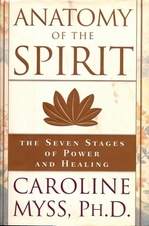
Anatomy of the Spirit: The Seven Stages of Power and Healing by Caroline Myss
Anatomy of the Spirit is the boldest presentation to date of energy medicine by one of its premier practitioners, internationally acclaimed medical intuitive Caroline Myss, one of the "hottest new voices in the alternative health/spirituality scene" (Publishers Weekly). Based on fifteen years of research into energy medicine, Dr. Myss's work shows how every illness corresponds to a pattern of emotional and psychological stresses, beliefs, and attitudes that have influenced corresponding areas of the human body.

The Anatomy of Hope: How People Prevail in the Face of Illness by Jerome Groopman, M.D.
Why do some people find and sustain hope during difficult circumstances, while others do not? What can we learn from those who do, and how is their example applicable to our own lives? The Anatomy of Hope is a journey of inspiring discovery, spanning some thirty years of Dr. Jerome Groopman’s practice, during which he encountered many extraordinary people and sought to answer these questions. This profound exploration begins when Groopman was a medical student, ignorant of the vital role of hope in patients’ lives–and it culminates in his remarkable quest to delineate a biology of hope. With appreciation for the human elements and the science, Groopman explains how to distinguish true hope from false hope–and how to gain an honest understanding of the reach and limits of this essential emotion
Why do some people find and sustain hope during difficult circumstances, while others do not? What can we learn from those who do, and how is their example applicable to our own lives? The Anatomy of Hope is a journey of inspiring discovery, spanning some thirty years of Dr. Jerome Groopman’s practice, during which he encountered many extraordinary people and sought to answer these questions. This profound exploration begins when Groopman was a medical student, ignorant of the vital role of hope in patients’ lives–and it culminates in his remarkable quest to delineate a biology of hope. With appreciation for the human elements and the science, Groopman explains how to distinguish true hope from false hope–and how to gain an honest understanding of the reach and limits of this essential emotion

Eat Pray Love by Elizabeth Gilbert
This beautifully written, heartfelt memoir touched a nerve among both readers and reviewers. Elizabeth Gilbert tells how she made the difficult choice to leave behind all the trappings of modern American success (marriage, house in the country, career) and find, instead, what she truly wanted from life. Setting out for a year to study three different aspects of her nature amid three different cultures, Gilbert explored the art of pleasure in Italy and the art of devotion in India, and then a balance between the two on the Indonesian island of Bali. By turns rapturous and rueful, this wise and funny author (whom Booklist calls “Anne Lamott’s hip, yoga- practicing, footloose younger sister”) is poised to garner yet more adoring fans.
This beautifully written, heartfelt memoir touched a nerve among both readers and reviewers. Elizabeth Gilbert tells how she made the difficult choice to leave behind all the trappings of modern American success (marriage, house in the country, career) and find, instead, what she truly wanted from life. Setting out for a year to study three different aspects of her nature amid three different cultures, Gilbert explored the art of pleasure in Italy and the art of devotion in India, and then a balance between the two on the Indonesian island of Bali. By turns rapturous and rueful, this wise and funny author (whom Booklist calls “Anne Lamott’s hip, yoga- practicing, footloose younger sister”) is poised to garner yet more adoring fans.

Zen Mind Beginners Mind: Informal talks on Zen Meditation by Shunryu Suzuki
This book is about how to practice Zen as a workable discipline and religion, about posture and breathing, about the basic attitudes and understanding that make Zen practice possible, about non-duality, emptiness, and enlightenment. Here one begins to understand what Zen is really about. And, most important of all, every page breathes with the joy and simplicity that make a liberated life possible. The book originated from a series of talks given by Zen Master Shunryu Suzuki to a small group in Los Altos, California. Says the author, "The world is its own magic" -- a feeling that pervades the entire book.
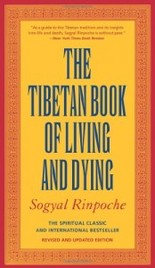
The Tibetan Book of Living and Dying by Sogyal Rinpoche
“A magnificent achievement. In its power to touch the heart, to awaken consciousness, [The Tibetan Book of Living and Dying] is an inestimable gift.” --San Francisco Chronicle
A newly revised and updated edition of the internationally bestselling spiritual classic, The Tibetan Book of Living and Dying, written by Sogyal Rinpoche, is the ultimate introduction to Tibetan Buddhist wisdom. An enlightening, inspiring, and comforting manual for life and death that the New York Times calls, “The Tibetan equivalent of [Dante’s] The Divine Comedy,” this is the essential work that moved Huston Smith, author of The World’s Religions, to proclaim, “I have encountered no book on the interplay of life and death that is more comprehensive, practical, and wise.”
“A magnificent achievement. In its power to touch the heart, to awaken consciousness, [The Tibetan Book of Living and Dying] is an inestimable gift.” --San Francisco Chronicle
A newly revised and updated edition of the internationally bestselling spiritual classic, The Tibetan Book of Living and Dying, written by Sogyal Rinpoche, is the ultimate introduction to Tibetan Buddhist wisdom. An enlightening, inspiring, and comforting manual for life and death that the New York Times calls, “The Tibetan equivalent of [Dante’s] The Divine Comedy,” this is the essential work that moved Huston Smith, author of The World’s Religions, to proclaim, “I have encountered no book on the interplay of life and death that is more comprehensive, practical, and wise.”

Modern Buddhism: The Path of Compassion and Wisdom by Geshe Kelsang Gyatso
A dynamic and comprehensive presentation of Buddha’s teachings, including practical explanations on how to attain lasting happiness and freedom from problems for ourselves and others. With clear and accessible language, Geshe Kelsang Gyatso guides the reader from the fundamentals of Buddhist meditation and philosophy, through a powerful explanation of the true nature of reality, to reveal the preciousness of Tantra—offering the paths to liberation and enlightenment to modern, busy people. A brief history of Kadampa Buddhism shows how Buddha’s timeless teachings have traveled from teacher to student over thousands of years, and how Buddhists in the West are now applying what was once available only to mystics and monks—practical advice to solve our daily problems and accomplish the real meaning of our human life. This inspiring handbook for daily practice is designed for those seeking solutions within Buddhism to the problems of everyday life, as well as to encourage people of all faiths to deepen their understanding and enjoyment of the spiritual paths.
A dynamic and comprehensive presentation of Buddha’s teachings, including practical explanations on how to attain lasting happiness and freedom from problems for ourselves and others. With clear and accessible language, Geshe Kelsang Gyatso guides the reader from the fundamentals of Buddhist meditation and philosophy, through a powerful explanation of the true nature of reality, to reveal the preciousness of Tantra—offering the paths to liberation and enlightenment to modern, busy people. A brief history of Kadampa Buddhism shows how Buddha’s timeless teachings have traveled from teacher to student over thousands of years, and how Buddhists in the West are now applying what was once available only to mystics and monks—practical advice to solve our daily problems and accomplish the real meaning of our human life. This inspiring handbook for daily practice is designed for those seeking solutions within Buddhism to the problems of everyday life, as well as to encourage people of all faiths to deepen their understanding and enjoyment of the spiritual paths.
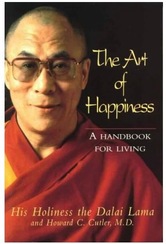
The Art of Happiness by His Holiness the Dalai Lama
The Art of Happiness is the book that started the genre of happiness books, and it remains the cornerstone of the field of positive psychology. Through conversations, stories, and meditations, the Dalai Lama shows us how to defeat day-to-day anxiety, insecurity, anger, and discouragement. Together with Dr. Howard Cutler, he explores many facets of everyday life, including relationships, loss, and the pursuit of wealth, to illustrate how to ride through life's obstacles on a deep and abiding source of inner peace. Based on 2,500 years of Buddhist meditations mixed with a healthy dose of common sense, The Art of Happiness is a book that crosses the boundaries of traditions to help readers with difficulties common to all human beings. After being in print for ten years, this book has touched countless lives and uplifted spirits around the world.
The Art of Happiness is the book that started the genre of happiness books, and it remains the cornerstone of the field of positive psychology. Through conversations, stories, and meditations, the Dalai Lama shows us how to defeat day-to-day anxiety, insecurity, anger, and discouragement. Together with Dr. Howard Cutler, he explores many facets of everyday life, including relationships, loss, and the pursuit of wealth, to illustrate how to ride through life's obstacles on a deep and abiding source of inner peace. Based on 2,500 years of Buddhist meditations mixed with a healthy dose of common sense, The Art of Happiness is a book that crosses the boundaries of traditions to help readers with difficulties common to all human beings. After being in print for ten years, this book has touched countless lives and uplifted spirits around the world.

The Mind of God by Paul Davies
Throughout history, humans have dreamed of knowing the reason for the existence of the universe. In The Mind of God, physicist Paul Davies explores whether modern science can provide the key that will unlock this last secret. In his quest for an ultimate explanation, Davies reexamines the great questions that have preoccupied humankind for millennia, and in the process explores, among other topics, the origin and evolution of the cosmos, the nature of life and consciousness, and the claim that our universe is a kind of gigantic computer. Charting the ways in which the theories of such scientists as Newton, Einstein, and more recently Stephen Hawking and Richard Feynman have altered our conception of the physical universe. Davies puts these scientists' discoveries into context with the writings of philosophers such as Plato. Descartes, Hume, and Kant. His startling conclusion is that the universe is "no minor byproduct of mindless, purposeless forces. We are truly meant to be here." By the means of science, we can truly see into the mind of God.
Throughout history, humans have dreamed of knowing the reason for the existence of the universe. In The Mind of God, physicist Paul Davies explores whether modern science can provide the key that will unlock this last secret. In his quest for an ultimate explanation, Davies reexamines the great questions that have preoccupied humankind for millennia, and in the process explores, among other topics, the origin and evolution of the cosmos, the nature of life and consciousness, and the claim that our universe is a kind of gigantic computer. Charting the ways in which the theories of such scientists as Newton, Einstein, and more recently Stephen Hawking and Richard Feynman have altered our conception of the physical universe. Davies puts these scientists' discoveries into context with the writings of philosophers such as Plato. Descartes, Hume, and Kant. His startling conclusion is that the universe is "no minor byproduct of mindless, purposeless forces. We are truly meant to be here." By the means of science, we can truly see into the mind of God.

Siddhartha by Hermann Hesse
It is better to conquer yourself than to win a thousand battles. Then the victory is yours. It cannot be taken from you, not by angels or by demons, heaven or hell.
Siddhartha is a novel by Hermann Hesse that deals with the spiritual journey of self-discovery of a man named Siddhartha during the time of the Buddha. The book, Hesse's ninth novel (1922), was written in German, in a simple, lyrical style. It was published in the U.S. in 1951 and became influential during the 1960s. The word Siddhartha is made up of two words in the Sanskrit language, siddha (achieved) + artha (meaning or wealth), which together means "he who has found meaning (of existence)" or "he who has attained his goals". In fact, the Buddha's own name, before his renunciation, was Siddhartha Gautama, Prince of Kapilvastu. In this book, the Buddha is referred to as "Gotama".
It is better to conquer yourself than to win a thousand battles. Then the victory is yours. It cannot be taken from you, not by angels or by demons, heaven or hell.
Siddhartha is a novel by Hermann Hesse that deals with the spiritual journey of self-discovery of a man named Siddhartha during the time of the Buddha. The book, Hesse's ninth novel (1922), was written in German, in a simple, lyrical style. It was published in the U.S. in 1951 and became influential during the 1960s. The word Siddhartha is made up of two words in the Sanskrit language, siddha (achieved) + artha (meaning or wealth), which together means "he who has found meaning (of existence)" or "he who has attained his goals". In fact, the Buddha's own name, before his renunciation, was Siddhartha Gautama, Prince of Kapilvastu. In this book, the Buddha is referred to as "Gotama".
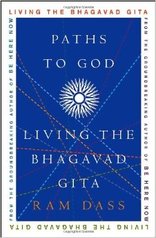
Paths to God by Ram Dass
World-renowned philosopher and spiritual teacher Ram Dass—author of the groundbreaking classic Be Here Now—presents the contemporary Western audience with a lively, accessible guide to the teachings of the Bhagavad Gita, the classic Hindu text that has been called the ultimate instruction manual for living a spiritual life.
World-renowned philosopher and spiritual teacher Ram Dass—author of the groundbreaking classic Be Here Now—presents the contemporary Western audience with a lively, accessible guide to the teachings of the Bhagavad Gita, the classic Hindu text that has been called the ultimate instruction manual for living a spiritual life.

The Bhagavad Gita by Jack Hawley
The Bhagavad Gita has been called India’s greatest contribution to the world. For more than five thousand years, this great scripture has shown millions in the East how to fill their lives with serenity and love. In these pages, Jack Hawley brings these ancient secrets to Western seekers in a beautiful prose version that makes the story of the Gita clear and exciting, and makes its truths understandable and easy to apply to our busy lives.
The Gita is a universal love song sung by God to His friend man. It can’t be confined by any creed. It is a statement of the truths at the core of what we all already believe, only it makes those truths clearer, so they become immediately useful in our daily lives. These truths are for our hearts, not just our heads. The Gita is more than just a book, more than mere words or concepts. There is an accumulated potency in it. To read the Gita is to be inspired in the true sense of the term: to be “in-spirited,” to inhale the ancient and ever-new breath of spiritual energy.
The Bhagavad Gita has been called India’s greatest contribution to the world. For more than five thousand years, this great scripture has shown millions in the East how to fill their lives with serenity and love. In these pages, Jack Hawley brings these ancient secrets to Western seekers in a beautiful prose version that makes the story of the Gita clear and exciting, and makes its truths understandable and easy to apply to our busy lives.
The Gita is a universal love song sung by God to His friend man. It can’t be confined by any creed. It is a statement of the truths at the core of what we all already believe, only it makes those truths clearer, so they become immediately useful in our daily lives. These truths are for our hearts, not just our heads. The Gita is more than just a book, more than mere words or concepts. There is an accumulated potency in it. To read the Gita is to be inspired in the true sense of the term: to be “in-spirited,” to inhale the ancient and ever-new breath of spiritual energy.

The Upanishads by Eknath Easwaren
Among the oldest of India's spiritual texts, the Upanishads are records of intensive question-and-answer sessions given by illumined sages to their students. Widely featured in philosophy courses, the Upanishads have puzzled and inspired wisdom seekers from Yeats to Schopenhauer. Eknath Easwaran makes this challenging text more accessible by selecting the passages most relevant to readers seeking timeless truths today.
Among the oldest of India's spiritual texts, the Upanishads are records of intensive question-and-answer sessions given by illumined sages to their students. Widely featured in philosophy courses, the Upanishads have puzzled and inspired wisdom seekers from Yeats to Schopenhauer. Eknath Easwaran makes this challenging text more accessible by selecting the passages most relevant to readers seeking timeless truths today.
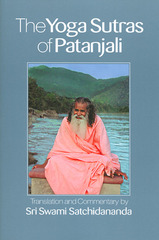
The Yoga Sutras of Patanjali by Sri Swami Satchidananda
This valuable book provides a complete manual for the study and practice of Raja Yoga, the path of concentration and meditation. This new edition of these timeless teachings is a treasure to be read and referred to again and again by seekers treading the spiritual path. The classic Sutras (thought-threads), at least four thousand years old, cover the yogic teachings on ethics, meditation, and physical postures, and provide directions for dealing with situations in daily life. The Sutras are presented here in the purest form, with the original Sanskrit and with translation, transliteration, and commentary by Sri Swami Satchidananda, one of the most respected and revered contemporary Yoga masters. In this classic context, Sri Swami offers practical advice, based on his own experience, for mastering the mind and achieving physical, mental, and emotional harmony.
This valuable book provides a complete manual for the study and practice of Raja Yoga, the path of concentration and meditation. This new edition of these timeless teachings is a treasure to be read and referred to again and again by seekers treading the spiritual path. The classic Sutras (thought-threads), at least four thousand years old, cover the yogic teachings on ethics, meditation, and physical postures, and provide directions for dealing with situations in daily life. The Sutras are presented here in the purest form, with the original Sanskrit and with translation, transliteration, and commentary by Sri Swami Satchidananda, one of the most respected and revered contemporary Yoga masters. In this classic context, Sri Swami offers practical advice, based on his own experience, for mastering the mind and achieving physical, mental, and emotional harmony.

Light on Yoga by B.K.S. Iyengar
The definitive guide to the philosophy and practice of Yoga--the ancient healing discipline for body and mind--by its greatest living teacher. Light on Yoga provides complete descriptions and illustrations of all the positions and breathing exercises. Features a foreword by Yehudi Menuhin. Illustrations throughout.
Bellur Krishnamachar Sundararaja Iyengar, better known as B.K.S. Iyengar, was the founder of the style of yoga known as "Iyengar Yoga" and was considered one of the foremost yoga teachers in the world.
The definitive guide to the philosophy and practice of Yoga--the ancient healing discipline for body and mind--by its greatest living teacher. Light on Yoga provides complete descriptions and illustrations of all the positions and breathing exercises. Features a foreword by Yehudi Menuhin. Illustrations throughout.
Bellur Krishnamachar Sundararaja Iyengar, better known as B.K.S. Iyengar, was the founder of the style of yoga known as "Iyengar Yoga" and was considered one of the foremost yoga teachers in the world.
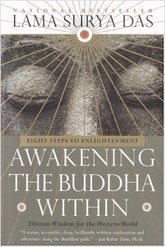
Lama Surya Das, the most highly trained American lama in the Tibetan tradition, presents the definitive book on Western Buddhism for the modern-day spiritual seeker. The radical and compelling message of Buddhism tells us that each of us has the wisdom, awareness, love, and power of the Buddha within; yet most of us are too often like sleeping Buddhas. In Awakening the Buddha Within, Surya Das shows how we can awaken to who we really are in order to lead a more compassionate, enlightened, and balanced life. It illuminates the guidelines and key principles embodied in the noble Eight-Fold Path and the traditional Three Enlightenment Trainings common to all schools of Buddhism: Wisdom Training: Developing clear vision, insight, and inner understanding -- seeing reality and ourselves as we really are. Ethics Training: Cultivating virtue, self-discipline, and compassion in what we say and do.
Meditation Training: Practicing mindfulness, concentration, and awareness of the present moment.
With lively stories, meditations, and spiritual practices, Awakening the Buddha Within is an invaluable text for the novice and experienced student of Buddhism alike.
Meditation Training: Practicing mindfulness, concentration, and awareness of the present moment.
With lively stories, meditations, and spiritual practices, Awakening the Buddha Within is an invaluable text for the novice and experienced student of Buddhism alike.

Autobiography of a Yogi is at once a beautifully written account of an exceptional life and a profound introduction to the ancient science of Yoga and its time-honored tradition of meditation. Profoundly inspiring, it is at the same time vastly entertaining, warmly humorous and filled with extraordinary personages.Self-Realization Fellowship's editions, and none others, include extensive material added by the author after the first edition was published, including a final chapter on the closing years of his life.
With engaging candor, eloquence, and wit, Paramahansa Yogananda tells the inspiring chronicle of his life: the experiences of his remarkable childhood, encounters with many saints and sages during his youthful search throughout India for an illumined teacher, ten years of training in the hermitage of a revered yoga master, and the thirty years that he lived and taught in America. Also recorded here are his meetings with Mahatma Gandhi, Rabindranath Tagore, Luther Burbank, the Catholic stigmatist Therese Neumann, and other celebrated spiritual personalities of East and West. The author clearly explains the subtle but definite laws behind both the ordinary events of everyday life and the extraordinary events commonly termed miracles. His absorbing life story becomes the background for a penetrating and unforgettable look at the ultimate mysteries of human existence
With engaging candor, eloquence, and wit, Paramahansa Yogananda tells the inspiring chronicle of his life: the experiences of his remarkable childhood, encounters with many saints and sages during his youthful search throughout India for an illumined teacher, ten years of training in the hermitage of a revered yoga master, and the thirty years that he lived and taught in America. Also recorded here are his meetings with Mahatma Gandhi, Rabindranath Tagore, Luther Burbank, the Catholic stigmatist Therese Neumann, and other celebrated spiritual personalities of East and West. The author clearly explains the subtle but definite laws behind both the ordinary events of everyday life and the extraordinary events commonly termed miracles. His absorbing life story becomes the background for a penetrating and unforgettable look at the ultimate mysteries of human existence

The Four Agreements by Don Miguel Ruiz
"Sit at the foot of a native elder and listen as great wisdom of days long past is passed down. In The Four Agreements shamanic teacher and healer Don Miguel Ruiz exposes self-limiting beliefs and presents a simple yet effective code of personal conduct learned from his Toltec ancestors. Full of grace and simple truth, this handsomely designed book makes a lovely gift for anyone making an elementary change in life, and it reads in a voice that you would expect from an indigenous shaman. The four agreements are these: Be impeccable with your word. Don't take anything personally. Don't make assumptions. Always do your best. It's the how and why one should do these things that make The Four Agreements worth reading and remembering." --P. Randall Cohan
"Sit at the foot of a native elder and listen as great wisdom of days long past is passed down. In The Four Agreements shamanic teacher and healer Don Miguel Ruiz exposes self-limiting beliefs and presents a simple yet effective code of personal conduct learned from his Toltec ancestors. Full of grace and simple truth, this handsomely designed book makes a lovely gift for anyone making an elementary change in life, and it reads in a voice that you would expect from an indigenous shaman. The four agreements are these: Be impeccable with your word. Don't take anything personally. Don't make assumptions. Always do your best. It's the how and why one should do these things that make The Four Agreements worth reading and remembering." --P. Randall Cohan
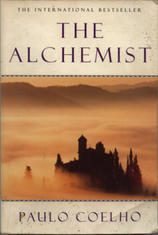
The Alchemist by Paulo Coelho
"My heart is afraid that it will have to suffer," the boy told the alchemist one night as they looked up at the moonless sky." Tell your heart that the fear of suffering is worse than the suffering itself. And that no heart has ever suffered when it goes in search of its dreams."
The Alchemist is the magical story of Santiago, an Andalusian shepherd boy who yearns to travel in search of a worldly treasure as extravagant as any ever found. From his home in Spain he journeys to the markets of Tangiers and across the Egyptian desert to a fateful encounter with the alchemist. The story of the treasures Santiago finds along the way teaches us, as only a few stories have done, about the essential wisdom of listening to our hearts, learning to read the omens strewn along life's path, and, above all, following our dreams.
"My heart is afraid that it will have to suffer," the boy told the alchemist one night as they looked up at the moonless sky." Tell your heart that the fear of suffering is worse than the suffering itself. And that no heart has ever suffered when it goes in search of its dreams."
The Alchemist is the magical story of Santiago, an Andalusian shepherd boy who yearns to travel in search of a worldly treasure as extravagant as any ever found. From his home in Spain he journeys to the markets of Tangiers and across the Egyptian desert to a fateful encounter with the alchemist. The story of the treasures Santiago finds along the way teaches us, as only a few stories have done, about the essential wisdom of listening to our hearts, learning to read the omens strewn along life's path, and, above all, following our dreams.

Life & Teaching of the Master of the Far East by Baird T. Spalding
Since these Masters were scattered over a wide territory that covered a large portion of India, Tibet, China, and Persia, they knew it could take years of searching many secluded villages and hidden mountain communes. Planning each step of the journey became a challenge knowing that countless miles of rugged terrain separated the remote and isolate locations that were imperative to the exploration. Even though they could plot their route on a map and see where they were headed, the destination deep within the souls of eleven scientifically trained men remained uncertain. Baird T. Spalding and the others were practical in nature and the thought of spiritual masters performing miracles seemed impossible. Despite these suspect thoughts, something compelled them to move onward. So they did. "The Masters accept that Buddha represents the Way to Enlightenment, but they clearly set forth that Christ IS Enlightenment, or a state of consciousness for which we are all seeking - the Christ light of every individual; therefore, the light of every child born into the world."
Since these Masters were scattered over a wide territory that covered a large portion of India, Tibet, China, and Persia, they knew it could take years of searching many secluded villages and hidden mountain communes. Planning each step of the journey became a challenge knowing that countless miles of rugged terrain separated the remote and isolate locations that were imperative to the exploration. Even though they could plot their route on a map and see where they were headed, the destination deep within the souls of eleven scientifically trained men remained uncertain. Baird T. Spalding and the others were practical in nature and the thought of spiritual masters performing miracles seemed impossible. Despite these suspect thoughts, something compelled them to move onward. So they did. "The Masters accept that Buddha represents the Way to Enlightenment, but they clearly set forth that Christ IS Enlightenment, or a state of consciousness for which we are all seeking - the Christ light of every individual; therefore, the light of every child born into the world."
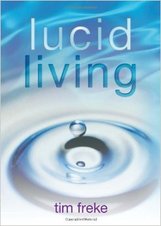
Lucid Living by Tim Freke
Life is not what it seems, you are not who you think you are....a book you can read in an hour that will turn your world inside out
Life is not what it seems, you are not who you think you are....a book you can read in an hour that will turn your world inside out

The Seat of the Soul by Gary Zukav
The Seat of the Soul became a national bestseller when it was first published, but more people are buying it now than ever before. Why is this? It is because a new species is being born. The Seat of the Soul is about this birth. This new species longs for harmony, cooperation, sharing, and reverence for Life. It uses higher orders of logic and justice -- those of the heart. The number of people who are becoming aware of this birth is growing very fast, because the new species is being born inside all of us. The Seat of the Soul provides a vocabulary for this new species -- a vocabulary of authentic power, the alignment of the personality with the soul. Human experience is exploding beyond the five senses, and The Seat of the Soul is about that, too. This is the most exciting time to be on Earth, and The Seat of the Soul describes why.
The Seat of the Soul became a national bestseller when it was first published, but more people are buying it now than ever before. Why is this? It is because a new species is being born. The Seat of the Soul is about this birth. This new species longs for harmony, cooperation, sharing, and reverence for Life. It uses higher orders of logic and justice -- those of the heart. The number of people who are becoming aware of this birth is growing very fast, because the new species is being born inside all of us. The Seat of the Soul provides a vocabulary for this new species -- a vocabulary of authentic power, the alignment of the personality with the soul. Human experience is exploding beyond the five senses, and The Seat of the Soul is about that, too. This is the most exciting time to be on Earth, and The Seat of the Soul describes why.
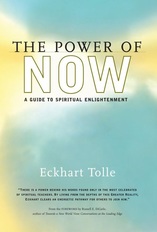
The Power of Now by Eckhart Tolle
It's no wonder that The Power of Now has sold over 2 million copies worldwide and has been translated into over 30 foreign languages. Much more than simple principles and platitudes, the book takes readers on an inspiring spiritual journey to find their true and deepest self and reach the ultimate in personal growth and spirituality: the discovery of truth and light.
It's no wonder that The Power of Now has sold over 2 million copies worldwide and has been translated into over 30 foreign languages. Much more than simple principles and platitudes, the book takes readers on an inspiring spiritual journey to find their true and deepest self and reach the ultimate in personal growth and spirituality: the discovery of truth and light.
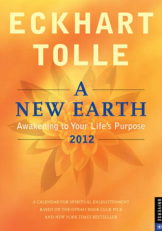
A New Earth by Eckhart Tolle
With his bestselling spiritual guide The Power of Now, Eckhart Tolle inspired millions of readers to discover the freedom and joy of a life lived "in the now." In A New Earth, Tolle expands on these powerful ideas to show how transcending our ego-based state of consciousness is not only essential to personal happiness, but also the key to ending conflict and suffering throughout the world. Tolle describes how our attachment to the ego creates the dysfunction that leads to anger, jealousy, and unhappiness, and shows readers how to awaken to a new state of consciousness and follow the path to a truly fulfilling existence.
With his bestselling spiritual guide The Power of Now, Eckhart Tolle inspired millions of readers to discover the freedom and joy of a life lived "in the now." In A New Earth, Tolle expands on these powerful ideas to show how transcending our ego-based state of consciousness is not only essential to personal happiness, but also the key to ending conflict and suffering throughout the world. Tolle describes how our attachment to the ego creates the dysfunction that leads to anger, jealousy, and unhappiness, and shows readers how to awaken to a new state of consciousness and follow the path to a truly fulfilling existence.
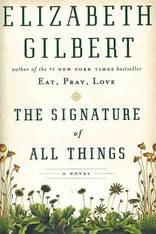
The Signature of All Things by Elizabeth Gilbert
Exquisitely researched and told at a galloping pace, The Signature of All Things soars across the globe—from London to Peru to Philadelphia to Tahiti to Amsterdam, and beyond. Along the way, the story is peopled with unforgettable characters: missionaries, abolitionists, adventurers, astronomers, sea captains, geniuses, and the quite mad. But most memorable of all, it is the story of Alma Whittaker, who—born in the Age of Enlightenment, but living well into the Industrial Revolution—bears witness to that extraordinary moment in human history when all the old assumptions about science, religion, commerce, and class were exploding into dangerous new ideas. Written in the bold, questing spirit of that singular time, Gilbert’s wise, deep, and spellbinding tale is certain to capture the hearts and minds of readers.
Exquisitely researched and told at a galloping pace, The Signature of All Things soars across the globe—from London to Peru to Philadelphia to Tahiti to Amsterdam, and beyond. Along the way, the story is peopled with unforgettable characters: missionaries, abolitionists, adventurers, astronomers, sea captains, geniuses, and the quite mad. But most memorable of all, it is the story of Alma Whittaker, who—born in the Age of Enlightenment, but living well into the Industrial Revolution—bears witness to that extraordinary moment in human history when all the old assumptions about science, religion, commerce, and class were exploding into dangerous new ideas. Written in the bold, questing spirit of that singular time, Gilbert’s wise, deep, and spellbinding tale is certain to capture the hearts and minds of readers.

I'm Off Then: Losing and Finding Myself on the Camino de Santiago by Hape Kerkeling
Overweight, overworked, and physically unfit, Kerkeling was an unlikely candidate to make the arduous pilgrimage across the French Alps to the Spanish Shrine of St. James, a 1,200-year-old journey undertaken by nearly 100,000 people every year. But that didn’t stop him from getting off the couch and walking. Along the way, lonely and searching for meaning, he began the journal that turned into this utterly frank, engaging book. Simply by struggling with his physical limitations and the rigors of long-distance walking, he discovered a deep sense of peace that transformed his life and allowed him to forgive himself, and others, more readily. He learned something every day, and he took to finishing each entry with his daily lessons.
Filled with quirky fellow pilgrims, historic landscapes, and Kerkeling’s self-deprecating sense of humor, I’m Off Then is an inspiring travelogue, a publishing phenomenon, and a spiritual journey unlike any other.
Overweight, overworked, and physically unfit, Kerkeling was an unlikely candidate to make the arduous pilgrimage across the French Alps to the Spanish Shrine of St. James, a 1,200-year-old journey undertaken by nearly 100,000 people every year. But that didn’t stop him from getting off the couch and walking. Along the way, lonely and searching for meaning, he began the journal that turned into this utterly frank, engaging book. Simply by struggling with his physical limitations and the rigors of long-distance walking, he discovered a deep sense of peace that transformed his life and allowed him to forgive himself, and others, more readily. He learned something every day, and he took to finishing each entry with his daily lessons.
Filled with quirky fellow pilgrims, historic landscapes, and Kerkeling’s self-deprecating sense of humor, I’m Off Then is an inspiring travelogue, a publishing phenomenon, and a spiritual journey unlike any other.

One hundred years of Solitude by Gabriel Garcia Marquez
One of the most influential literary works of our time, One Hundred Years of Solitude is a dazzling and original achievement by the masterful Gabriel García Márquez, winner of the Nobel Prize for Literature.
One Hundred Years of Solitude tells the story of the rise and fall, birth and death of the mythical town of Macondo through the history of the Buendía family. Inventive, amusing, magnetic, sad, and alive with unforgettable men and women -- brimming with truth, compassion, and a lyrical magic that strikes the soul -- this novel is a masterpiece in the art of fiction.
One of the most influential literary works of our time, One Hundred Years of Solitude is a dazzling and original achievement by the masterful Gabriel García Márquez, winner of the Nobel Prize for Literature.
One Hundred Years of Solitude tells the story of the rise and fall, birth and death of the mythical town of Macondo through the history of the Buendía family. Inventive, amusing, magnetic, sad, and alive with unforgettable men and women -- brimming with truth, compassion, and a lyrical magic that strikes the soul -- this novel is a masterpiece in the art of fiction.
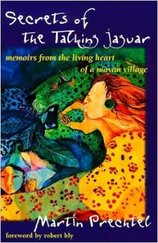
Secrets of the Talking Jaguar by Martin Prechtel
Twenty-five years ago, a young musician and painter named Martin Prechtel wandered through the brilliant landscapes of Mexico and Guatemala. Arriving at Santiago Atitlan, a Tzutujil Mayan village on the breathtaking shores of Lake Atitlan, Prechtel met Nicolas Chiviliu Tacaxoy--perhaps the most famous shaman in Tzutujil history--who believed Prechtel was the new student he had asked the gods to provide. For the next thirteen years, Prechtel studied the ancient Tzutujil culture and became a village chief and a famous shaman in his own right. In Secrets of the Talking Jaguar, Prechtel brings to vivid life the sights, sounds, scents, and colors of Santiago Atitlan: its magical personalities, its beauty, its material poverty and spiritual richness, its eight-hundred-year-old rituals juxtaposed with quintessential small-town gossip. The story of his education is a tale filled with enchantment, danger, passion, and hope.
Twenty-five years ago, a young musician and painter named Martin Prechtel wandered through the brilliant landscapes of Mexico and Guatemala. Arriving at Santiago Atitlan, a Tzutujil Mayan village on the breathtaking shores of Lake Atitlan, Prechtel met Nicolas Chiviliu Tacaxoy--perhaps the most famous shaman in Tzutujil history--who believed Prechtel was the new student he had asked the gods to provide. For the next thirteen years, Prechtel studied the ancient Tzutujil culture and became a village chief and a famous shaman in his own right. In Secrets of the Talking Jaguar, Prechtel brings to vivid life the sights, sounds, scents, and colors of Santiago Atitlan: its magical personalities, its beauty, its material poverty and spiritual richness, its eight-hundred-year-old rituals juxtaposed with quintessential small-town gossip. The story of his education is a tale filled with enchantment, danger, passion, and hope.

Your Seven Energy Centers: A Holistic Approach To Physical, Emotional And Spiritual Vitality by Elizabeth Prophet
What are chakras? Why are they important? Explains what each chakra does and how to use them in everyday life. Contains powerful insights and tools for wholeness based on the study of the body's subtle energy system.
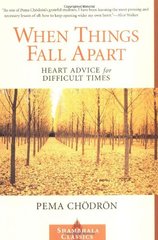
When Things Fall Apart: Heart Advice for Difficult Times by Pema Chodron
The beautiful practicality of her teaching has made Pema Chödrön one of the most beloved of contemporary American spiritual authors among Buddhists and non-Buddhists alike. A collection of talks she gave between 1987 and 1994, the book is a treasury of wisdom for going on living when we are overcome by pain and difficulties. Chödrön discusses:
• Using painful emotions to cultivate wisdom, compassion, and courage
• Communicating so as to encourage others to open up rather than shut down
• Practices for reversing habitual patterns
• Methods for working with chaotic situations
• Ways for creating effective social action
The beautiful practicality of her teaching has made Pema Chödrön one of the most beloved of contemporary American spiritual authors among Buddhists and non-Buddhists alike. A collection of talks she gave between 1987 and 1994, the book is a treasury of wisdom for going on living when we are overcome by pain and difficulties. Chödrön discusses:
• Using painful emotions to cultivate wisdom, compassion, and courage
• Communicating so as to encourage others to open up rather than shut down
• Practices for reversing habitual patterns
• Methods for working with chaotic situations
• Ways for creating effective social action

Law of Life & Teaching from Divine Beings by Adk Luk
Alice Schultz, secretary for both the Ballards and Geraldine Innocenti, wrote nine volumes known as the yellow books. Taking the pen name ADK Luk she interprets all the I AM teachings in a wise and practical manner.
Alice Schultz, secretary for both the Ballards and Geraldine Innocenti, wrote nine volumes known as the yellow books. Taking the pen name ADK Luk she interprets all the I AM teachings in a wise and practical manner.

The Divine Within: Selected Writings on Enlightenment by Aldous Huxley
Brave New World author Aldous Huxley on enlightenment and the "ultimate reality"
In this anthology of twenty-six essays and other writings, Huxley discusses the nature of God, enlightenment, being,good and evil, religion, eternity, and the divine. Huxley consistently examined the spiritual basis of both the individual and human society, always seeking to reach an authentic and clearly defined experience of the divine. Featuring an introduction by renowned religious scholar Huston Smith, this celebration of "ultimate reality" proves relevant and prophetic in addressing the spiritual hunger so many feel today.
Brave New World author Aldous Huxley on enlightenment and the "ultimate reality"
In this anthology of twenty-six essays and other writings, Huxley discusses the nature of God, enlightenment, being,good and evil, religion, eternity, and the divine. Huxley consistently examined the spiritual basis of both the individual and human society, always seeking to reach an authentic and clearly defined experience of the divine. Featuring an introduction by renowned religious scholar Huston Smith, this celebration of "ultimate reality" proves relevant and prophetic in addressing the spiritual hunger so many feel today.
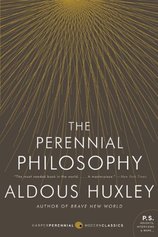
The Perennial Philosophy by Aldous Huxley
An inspired gathering of religious writings that reveals the "divine reality" common to all faiths, collected by Aldous Huxley.
"The Perennial Philosophy," Aldous Huxley writes, "may be found among the traditional lore of peoples in every region of the world, and in its fully developed forms it has a place in every one of the higher religions." With great wit and stunning intellect—drawing on a diverse array of faiths, including Zen Buddhism, Hinduism, Taoism, Christian mysticism, and Islam—Huxley examines the spiritual beliefs of various religious traditions and explains how they are united by a common human yearning to experience the divine. The Perennial Philosophy includes selections from Meister Eckhart, Rumi, and Lao Tzu, as well as the Bhagavad Gita, Tibetan Book of the Dead, Diamond Sutra, and Upanishads, among many others.
An inspired gathering of religious writings that reveals the "divine reality" common to all faiths, collected by Aldous Huxley.
"The Perennial Philosophy," Aldous Huxley writes, "may be found among the traditional lore of peoples in every region of the world, and in its fully developed forms it has a place in every one of the higher religions." With great wit and stunning intellect—drawing on a diverse array of faiths, including Zen Buddhism, Hinduism, Taoism, Christian mysticism, and Islam—Huxley examines the spiritual beliefs of various religious traditions and explains how they are united by a common human yearning to experience the divine. The Perennial Philosophy includes selections from Meister Eckhart, Rumi, and Lao Tzu, as well as the Bhagavad Gita, Tibetan Book of the Dead, Diamond Sutra, and Upanishads, among many others.

The Doors of Perception & Heaven and Hell by Aldous Huxley
In 1952 Aldous Huxley became involved in the now legendary experiment to clinically detail the physiological and psycho-logical effects of the little known drug used by Mexican and Native American elders in religious practices. The drug was Peyote-now commonly know as mescalin. By the standards of the time, Huxley was a hard working, respected, and reserved intellectual from a highly intelligent, well-know, and eccentric British family. By any standards, the results of the experiment were remarkable. The Doors of Perception and Heaven and Hell detail the practic-alities of the experiment and give Huxley's vivid account of his im-mediate experience and the more prolonged effect upon his sub-sequent thinking and awareness. At first, the reader is drawn in by the sheer naivety and tom-foolery of the proposal but is soon caught in a finely woven net by the juxtaposition of Huxley's formidable intellect, his remarkable ability to convey the experience in such acute and truthful detail, and his incredible modesty. For the con-scious and willing reader - a trip to the Guggenheim, the Louvre or the Tate Modern will never be the same again.
In 1952 Aldous Huxley became involved in the now legendary experiment to clinically detail the physiological and psycho-logical effects of the little known drug used by Mexican and Native American elders in religious practices. The drug was Peyote-now commonly know as mescalin. By the standards of the time, Huxley was a hard working, respected, and reserved intellectual from a highly intelligent, well-know, and eccentric British family. By any standards, the results of the experiment were remarkable. The Doors of Perception and Heaven and Hell detail the practic-alities of the experiment and give Huxley's vivid account of his im-mediate experience and the more prolonged effect upon his sub-sequent thinking and awareness. At first, the reader is drawn in by the sheer naivety and tom-foolery of the proposal but is soon caught in a finely woven net by the juxtaposition of Huxley's formidable intellect, his remarkable ability to convey the experience in such acute and truthful detail, and his incredible modesty. For the con-scious and willing reader - a trip to the Guggenheim, the Louvre or the Tate Modern will never be the same again.

The Psychedelic Experience - A manual based on the Tibetan Book of the Dead by Timothy Leary
This book is an excellent and concise manual on how to use the Tibetan Book of Living and Dying to be able to gain perception of the clear light. The reason for this book is NOT to give instant enlightenment. The purpose of this book is to practice the art of correct and conscious dying by using your mind to properly navigate the bardo. This book helps one to experience the state of samadhi or rigpa which is the state of non-dual consciousness. The experience of rigpa is necessary to the practice of the inner tantras like dzogchen.
This book helps us to gain understanding of the elements of exploring the idea of other levels of consciousness, which has been said to be reached by monks whom meditate for months, abstaining from food or water or those on vision quests - even though this book is about "the psychedelic experience", that is not the only way to achieve an understanding of what this book is explaining.
This book is an excellent and concise manual on how to use the Tibetan Book of Living and Dying to be able to gain perception of the clear light. The reason for this book is NOT to give instant enlightenment. The purpose of this book is to practice the art of correct and conscious dying by using your mind to properly navigate the bardo. This book helps one to experience the state of samadhi or rigpa which is the state of non-dual consciousness. The experience of rigpa is necessary to the practice of the inner tantras like dzogchen.
This book helps us to gain understanding of the elements of exploring the idea of other levels of consciousness, which has been said to be reached by monks whom meditate for months, abstaining from food or water or those on vision quests - even though this book is about "the psychedelic experience", that is not the only way to achieve an understanding of what this book is explaining.

Breaking open the Head: A psychedelic journey into the heart of contemporary shamanism by Daniel Pinchebeck
Breaking Open the Head is a passionate, multilayered, and sometimes rashly personal inquiry into this deep division. On one level, Daniel Pinchbeck tells the story of the encounters between the modern consciousness of the West and these sacramental substances, including such thinkers as Allen Ginsberg, Antonin Artaud, Walter Benjamin, and Terence McKenna, and a new underground of present-day ethnobotanists, chemists, psychonauts, and philosophers.
Breaking Open the Head is brave participatory journalism at its best, a vivid account of psychic and intellectual experiences that opened doors in the wall of Western rationalism and completed Daniel Pinchbeck's personal transformation from a jaded Manhattan journalist to shamanic initiate and grateful citizen of the cosmos.
Breaking Open the Head is a passionate, multilayered, and sometimes rashly personal inquiry into this deep division. On one level, Daniel Pinchbeck tells the story of the encounters between the modern consciousness of the West and these sacramental substances, including such thinkers as Allen Ginsberg, Antonin Artaud, Walter Benjamin, and Terence McKenna, and a new underground of present-day ethnobotanists, chemists, psychonauts, and philosophers.
Breaking Open the Head is brave participatory journalism at its best, a vivid account of psychic and intellectual experiences that opened doors in the wall of Western rationalism and completed Daniel Pinchbeck's personal transformation from a jaded Manhattan journalist to shamanic initiate and grateful citizen of the cosmos.
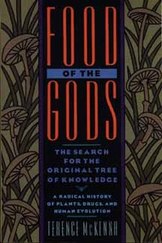
Food of the Gods: The search for the original tree of knowledge by Terrence McKenna
A radical history of plants, drugs and human evolution. This a book about higher dimensional reality, modern and ancestral hallucinogens, shamanism, catalyzing consciousness, human cognition, contacting the mind behind nature and psychopharmacology of caffeine, sugar, tobacco, LSD, Psilocybin, Ibogaine, Mescaline, Ecstasy, Marijuana, Opium, Cocaine and Alcohol
